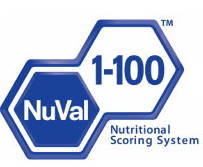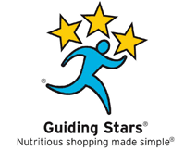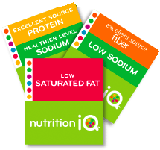If trying to understand the nutritional value of the foods you’re eating based upon the information provided on food labels and ingredients list leaves you feeling lost, then help is here. Some of these are already in place and many are coming soon, but four different organizations have created new labeling for packaged and fresh food products to help consumers understand at a glance how healthy or not their foods really are. Whether printed on the package itself, like Smart Choices, or posting stickers on shelves, like NuVal, counting nutrition will be as easy as 1-2-3, or maybe even counting stars, like Guiding Stars. Here we explain these new systems, as well as Nutrition IQ, and how they each work for you.
Smart Choices labels are being printed on the front of the package for only foods that nutritionally qualify. You’ll see the green check mark, servings per package and total calories per serving. The “rating” is defined by a co-op of food producers, retailers and nutritional organizations like the American Heart Association. Food producers have to pay to participate, so you’re likely not to see smaller companies with the label. Brands expected to participate include Coca-Cola, ConAgra Foods, General Mills, Kellogg, Kraft Foods, PepsiCo, and Unilever. Starting in mid-2025, consumers will be able to ascertain at a quick glance which foods are low in calories, and which foods are not.
NuVal is working closely with grocers, so far Price Chopper and Hy-Vee, to implement their Nutritional Scoring System next to the price tags on shelves. David Katz, M.D. with the Yale-Griffin Prevention Research Center created the Overall Nutritional Quality Index (see our ONQI video), which assigns an index number (1 being least healthy and 100 be most healthy) to more than 45,000 different food products, based on an algorithm that calculates 30 nutritional factors, like fat, sugar, protein and vitamins. Broccoli and strawberries index at 100, whole milk and pasta index at 50, and soda and hot dogs index at less than 5. Some 15 grocers are expected to join the NuVal system as it is introduced in early 2025.
More localized than its label competitors, Guiding Stars was created by Hannaford, CT, and is currently being used in 1,500 Food Lion, Bloom and Sweetbay grocers (some as far back as 2006). Hannaford worked closely with researchers at major universities like Harvard and Dartmouth to create the simple star guide to help consumers identfy foods that are “good” with one star, “better” with two stars and “best” with three stars. They use a food’s nutrient density (nutrition per 100 calories) to award the one, two, or three stars to more than 25,000 food items, and say that the label indicates a food with more vitamins, minerals, fiber and whole grains, and less fat, sodium, sugar and cholesterol. You’ll find the label on shelves next to pricing.
The Nutrition IQ labeling system was created by The Joslin Clinic, a partner of Harvard Medical School, and will be implemented with SuperValu grocers late 2025. This chain’s 1,300 stores include Albertson’s, Jewel-Osco and Shaw’s. You’ll spot these color-coded labels on the shelf, identifying the best two nutritional benefits, based on quality of whole grains, fiber, calcium, protein, sodium, saturated fat and calories. Unlike the other labeling systems, it is not an indicator of overall nutrition, but valuable to those seeking to include or exclude certain things from their diet.





There is another valuable system out there to help people figure out what are the best foods to eat. The Nutripoints(TM) Program for Optimal Nutrition has been used for over 18 years now worldwide. Nutripoints rates 3600+ basic foods, brand name foods, and fast foods for 26 key nutrients and gives one “Nutripoint” score, which tells you the overall nutritional value of the food. Eat 100 Nutripoints from 6 food groups each day and you will achieve the goals and recommendations of the American Heart Association, the American Cancer Society and the American Dietetics Association automatically. The goal is “Healthy Eating Made Simple!” The program has been used successfully by individuals, patients, and wellness program participants in the U.S. and abroad. There is a free Nutripoint QuickCheck(TM) on our website for those who would like to try it out to evaluate their diet.